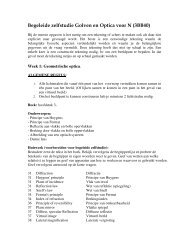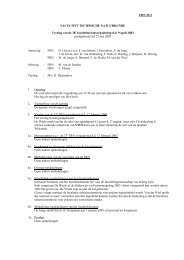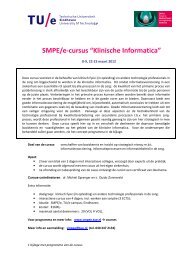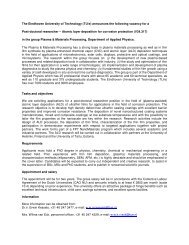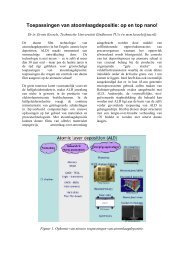Chimera States for Coupled Oscillators
Chimera States for Coupled Oscillators
Chimera States for Coupled Oscillators
You also want an ePaper? Increase the reach of your titles
YUMPU automatically turns print PDFs into web optimized ePapers that Google loves.
Where innovation starts<strong>Chimera</strong> <strong>States</strong> <strong>for</strong><strong>Coupled</strong> <strong>Oscillators</strong>Mark Naber 0571509Jeroen Willems 0575806November 2008
Contents2References 3Introduction 4Governing Equation 6Simulation 7Mean field theory 8Predict R(x) and Θ(x) theoretically 12Conclusion 21Questions 22/w
References3• Daniel M. Abrams, et al, "Solvable Model <strong>for</strong> <strong>Chimera</strong> <strong>States</strong> of <strong>Coupled</strong><strong>Oscillators</strong>", Phys. Rev. Lett. 101, 084103 (2008)• Daniel M. Abrams and Steven H. Strogatz, "<strong>Chimera</strong> <strong>States</strong> <strong>for</strong> <strong>Coupled</strong><strong>Oscillators</strong>", Phys. Rev. Lett. 93, 174102 (2004)• Steven H. Strogatz, "From Kuramoto to Craw<strong>for</strong>d: exploring the onset ofsynchronization in populations of coupled oscillators", Physica 143D, 1(2000)• Y. Kuramoto and D. Battogtokh, "Coexistence of Coherence and Incoherencein Nonlocally <strong>Coupled</strong> Phase <strong>Oscillators</strong>", Nonlinear Phenom. ComplexSyst. 5, 380 (2002)/w
Introduction4<strong>Chimera</strong>"A mythological, fire-breathing monster, commonly represented with a lion’shead, a goat’s body, and a serpent’s tail."/w
Introduction5<strong>Chimera</strong>A mathematical chimera:"An array of identical oscillators which splits in two domains."/w
Governing Equation6Governing Equation∫∂φπ∂t = ω −−πG(x − x ′ ) sin[φ(x, t) − φ(x ′ , t) + α]dx ′ (1)/w
Simulation7Discretized EquationSimulationφ i+1 = ω i − 1 NN∑G(x i − x j ) sin[φ i − φ j + α] (2)j=1/w
Mean field theory8• Focus on 1 oscillator• Generalize the surrounding oscillators/w
Mean field theory9Relative phase θRelative phase of an oscillator to the rotating frame ΩRearranging <strong>for</strong>mula 1 gives∂θ(x, t)∂t∫= ω − Ω −θ = φ − Ωt (3)G(x − x ′ ) × sin[θ(x, t) − θ(x ′ , t) + α]dx ′ (4)/w
Mean field theory10Complex order parameterIntroduction of the complex order parameter with modulus R and phase Θ.R(x, t) exp[iΘ(x, t)] =∫ π−πG(x ′ − x) exp[iθ(x ′ , t)]dx ′ (5)Substituting this equation into a one-oscillator equation 4 results in∂θ(x, t)∂t= ω − Ω − R(x, t) sin[θ(x, t) + α + Θ(x, t)] (6)This <strong>for</strong>mula shows that it is practically an assembly of independent oscillatorsunder control of a common field represented by R and Θ./w
Mean field theory11Time independence R and Θ• R(x, t) and Θ(x, t) in <strong>for</strong>mula 6.• A long-time average gives a time-independent spatial profile• Standard deviation of 0.008 <strong>for</strong> fluctuations in time./w
Predict R(x) and Θ(x) theoretically12The spatial profiles on the previous slide were determined practically.Theoretical determining R(x) and Θ(x) can be done in two ways.First method in determining R(x) and Θ(x)Determine solutions depending on depend on R(x) and Θ(x) of 7R(x, t) exp[iΘ(x, t)] =Substitute these solutions in 8∂θ(x, t)∂t∫ π−πG(x ′ − x) exp[iθ(x ′ , t)]dx ′ (7)= ω − Ω − R(x, t) sin(θ(x, t) + α + Θ(x, t)) (8)Which will lead to an equation <strong>for</strong> determining R(x) and Θ(x)./w
Predict R(x) and Θ(x) theoretically13Separation of 2 phasesThe figure shows 2 phase, which need te be treated separately.• The constant part is time-independent.• The drifting part has time dependency.3210−1−2−3−3 −2 −1 0 1 2 3/w
Predict R(x) and Θ(x) theoretically14Drifting phaseUse probability density p(θ, R), with the normalizing constant C.p(θ, R) = C(ω − Ω − R sin θ) −1 (9)The use of p(θ, R) gives an equilibrium <strong>for</strong> infinitely many oscillators.exp[iθ(x ′ , t)] changes to the statistical average 〈exp[iθ(x ′ , t)]〉/w
Predict R(x) and Θ(x) theoretically15Critical value x cThe spatial profile of R implies a critical value x c separating the the twophases.3210−1−2−3−3 −2 −1 0 1 2 3/w
Predict R(x) and Θ(x) theoretically16Functional self-consistency conditionR(x) exp[iΘ(x)] =h(R) =⎧⎨⎩∫ 10G(|x ′ − x|) exp[i(Θ(x ′ ) − α)]h(R(x ′ ))dx ′ (10)exp[iθ 0 (R)] (|x ′ − 1 2 | ≥ x c)∫ 2π0exp(iθ)p(θ, R)dθ (|x ′ − 1 2 | < x c)(11)/w
Predict R(x) and Θ(x) theoreticallyh(R) from <strong>for</strong>mula 11 can be made explicit, so we obtainWithR(x) exp[iΘ(x)] = e iβ ∫ πWhere ∆ = ω − Ω and β = π 2 − α−πG(|x ′ − x|) exp[iΘ(x ′ )]h(x ′ )dx ′ (12)h(x ′ ) = ∆ − √ ∆ 2 − R 2 (x ′ )R(x ′ )(13)17We take G(x) = 1 (1 + cos(x)) because2π1. The numerical curves suggests a cosine wave2. Equation 12 is solvable <strong>for</strong> any kernel of a finite Fourier <strong>for</strong>m→ R(x) and Θ(x) can be obtained explicitly/w
Predict R(x) and Θ(x) theoreticallyExpanding G with a trigonometric identity and using Fourier, 12 gives18Re iΘ = e iβ 〈he iΘ 〉 + Ae iβ 〈he iΘ cos(x ′ )〉 cos(x) (14)= c + a cos(x) (15)Where the angular brackets denotes the spatial average:〈f〉 = 12π∫ π−πf(x ′ )dx ′ (16)The sinus term is dropped because R(x ′ ) = R(−x ′ ) , Θ(x ′ ) = Θ(−x ′ )/w
Predict R(x) and Θ(x) theoreticallyThe assumed evenness implies <strong>for</strong>mulas <strong>for</strong> R(x) and Θ(x) that possess symmetryso R satisfies19To solve <strong>for</strong> a and c we first rewriteR 2 = (Re iΘ )(Re −iΘ ) (17)= (c + a cos(x))(c ∗ + a ∗ cos(x)) (18)= |c 2 | + 2Re(ca ∗ ) cos(x) + |a| 2 cos 2 (x) (19)he iΘ = (Re iΘ ) h R = ∆ − √ ∆ 2 − R 2 (x)c + a ∗ cos(x)(20)Making use of 15 we obtain/wc = e iβ 〈 ∆ − √ ∆ 2 − |c + a cos(x)| 2c + a ∗ cos(x)a = Ae iβ 〈 ∆ − √ ∆ 2 − |c + a cos(x)| 2c + a ∗ cos(x)〉 (21)cos(x) 〉 (22)
Predict R(x) and Θ(x) theoretically20• 4 real equations• 4 real unknowns (c, Re(a), Im(a), ∆)• Solutions can be expressed as function of β and AOutside the scope of this research./w
Conclusion21Conclusion• The meanfield assumption is allowed!/w
Questions22Questions ?/w



